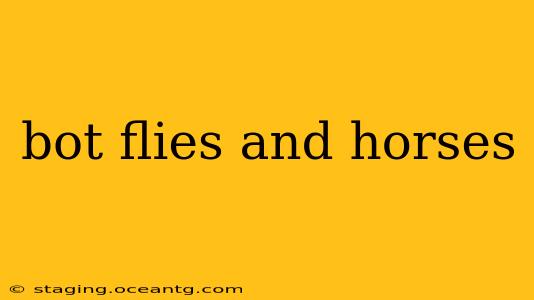Bot flies are a common nuisance for horse owners, causing discomfort and potential health problems for their equine companions. Understanding the lifecycle, effects, and treatment of bot flies is crucial for maintaining the well-being of your horse. This comprehensive guide delves into the intricacies of this parasitic relationship, answering many frequently asked questions.
What are Bot Flies?
Bot flies, specifically the species Gasterophilus intestinalis (the common horse bot fly), are obligate parasites, meaning they can only complete their lifecycle within a host—in this case, horses. They are characterized by their distinctive buzzing flight and the characteristic eggs they lay on the horse's coat. These eggs hatch, releasing larvae that burrow into the horse's skin or mouth, eventually making their way to the digestive tract where they mature.
What do Bot Fly Eggs Look like?
Horse bot fly eggs are small, oval-shaped, and typically a pale yellow or tan color. They're often found clustered together on the horse's hairs, particularly around the lips, nostrils, and legs. Their placement is strategically chosen to maximize the chances of ingestion by the horse. The eggs are firmly attached to the hair and are resistant to being brushed off easily.
How do Bot Flies Infect Horses?
The lifecycle of the horse bot fly is quite fascinating and has several stages:
- Egg Laying: Adult female bot flies deposit their eggs on the horse's hair.
- Larval Hatching: The eggs hatch when stimulated by the horse's licking or grooming behavior.
- Oral Ingestion (or Skin Penetration): The larvae then either burrow into the horse's mouth (species dependent), or are ingested with the horse's saliva.
- Digestive Tract Development: Once ingested, the larvae attach to the lining of the horse's stomach or intestines, where they feed and mature.
- Excretion: Mature larvae detach and pass out of the horse in the feces.
- Pupation: The larvae pupate in the ground, eventually emerging as adult flies to start the cycle anew.
How do I know if my horse has bot flies?
Signs of a bot fly infestation can vary, ranging from mild to severe. Early detection is crucial for effective management. Some common signs include:
- Visible Eggs: Observe your horse's coat regularly for clusters of tiny, oval-shaped eggs.
- Restlessness: Infected horses may show signs of discomfort, including restlessness, pawing, and rubbing.
- Poor Appetite: Heavy infestations can lead to a reduction in appetite and weight loss.
- Colic: In severe cases, large numbers of larvae can cause colic, a severe abdominal pain.
How are Bot Flies Treated?
Effective treatment aims to eliminate bot fly larvae before they mature. Common approaches include:
- Ivermectin Paste: This is a broad-spectrum anthelmintic (worm medication) highly effective against bot fly larvae. It's crucial to follow your veterinarian's recommendations regarding dosage and frequency.
- Regular Grooming: Thoroughly grooming your horse can help remove eggs before they hatch.
- Preventing Access to Eggs: Managing pasture conditions and minimizing contact with other infested horses can reduce the risk of re-infestation.
What are the long-term effects of bot flies on horses?
While most horses can tolerate a small number of bot fly larvae without significant health consequences, heavy infestations can lead to several issues:
- Gastritis: Irritation and inflammation of the stomach lining.
- Colic: Severe abdominal pain, often requiring veterinary intervention.
- Malnutrition: Reduced feed intake due to discomfort.
- Weakened Immune System: Chronic infestations can stress the horse's immune system, increasing susceptibility to other diseases.
Are bot flies dangerous to humans?
Adult bot flies are not known to bite or otherwise harm humans. The larvae are also not a threat to human health, though it's best to avoid direct contact to prevent accidental ingestion.
How can I prevent bot fly infestations?
Prevention is key to managing bot flies. Strategies include:
- Regular Deworming: Implement a strategic deworming program recommended by your veterinarian.
- Meticulous Grooming: Regularly brush your horse's coat to remove eggs.
- Pasture Management: Keep pastures clean and well-maintained to reduce the chances of larvae pupating in the soil.
This guide provides a comprehensive overview of bot flies and their impact on horses. Remember to consult with your veterinarian for tailored advice on preventing and managing bot fly infestations in your horse. Early detection and proactive measures are crucial for maintaining your horse's health and well-being.
